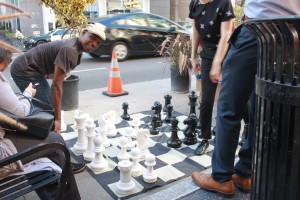 Editor’s note: This post was originally published on September 21, 2012. IPI invites you to participate in Park(ing) Day 2016. Send high-quality, original photos of your Park(ing) Day spaces to arpino@parking.org and they could be featured in The Parking Professional magazine. Be sure to include a brief summary of your efforts (200-300 words), photo credit, and full contact information in case we need to follow up.
Editor’s note: This post was originally published on September 21, 2012. IPI invites you to participate in Park(ing) Day 2016. Send high-quality, original photos of your Park(ing) Day spaces to arpino@parking.org and they could be featured in The Parking Professional magazine. Be sure to include a brief summary of your efforts (200-300 words), photo credit, and full contact information in case we need to follow up.
By Jeff Petry
Today is Park(ing) Day –an international day where our metered parking spaces turn into park spaces that promote creativity, civic engagement, critical thinking, unscripted social interactions, generosity and play.*
Why are we sometimes hesitant to embrace a concept such as Park(ing) Day? Have a seat on my couch and let’s talk about our anxieties:
- Safety: Having people, especially kids playing, in a parking space next to moving traffic is dangerous.
- No turnover: The space is essentially reserved all day long and the abutting businesses lose convenience customers.
- It challenges our thought: It can be difficult for us to think about an on-street parking space being used for something other than an automobile.
I understand these concerns, as they all went through my mind with my first experience of a Park(ing) Day. The top two disappeared when I saw the safe layout of the transformed spaces and neighborliness of the PARK-ers with adjacent businesses. (There is a free Park(ing) Day manual that addresses these issues, too.)
The last, I realized, was just a reaction to tackling something different from our day-to-day work, but the fresh perspective of Park(ing) Day provides a healthy challenge to our profession. We need to be pushed outside our comfort range to maintain a robust understanding of how our profession integrates into larger community concerns.
The mission behind Park(ing) Day, however, is not that different from other familiar situations. Many municipal and campus parking lots are viewed as land bank sites for future development. How many of us have had a surface lot converted to something else–likely a building or parking structure? How many of us carry this normal development scenario over to the on-street parking system? Is it really that big of a leap of parking faith to think about converting an on-street parking space to a different use, at least for a day?
We must recognize that our streets are public spaces that serve more than just a transportation function. Our public spaces provide the opportunity for social interactions, public gathering spaces, vending, events, and even sometimes temporary conversion to a park for a day. Park(ing) Day feeds into the concept of a Complete Street that aims to allow socioeconomic uses for our streets to coexist happily with our transportation needs year ‘round. Park(ing) Day provides a short-term experiment to help us and as our enlightened community members and decision makers visualize a different use of a metered, on-street parking space. It can also help us parking folks expand our professional roles and re-think the services our management can provide.
*Original Park(ing) Day concept by San Francisco-based Rebar Group.
Jeff Petry is parking and technology manager for the City of Eugene, Ore.
